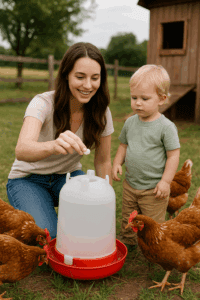Your Farmstead's Livestock Depend on Good Gut Health
Maintaining a healthy gut in poultry and livestock begins with clean, pathogen-free drinking water. Enter chlorine dioxide (ClO₂)—a proven water purification solution that works at low concentrations to neutralize biofilms, control harmful bacteria, and support overall animal health without disrupting beneficial microflora.
Let’s explore how ClO₂ works and how to accurately dose it using convenient tablets and test strips for effective gut health management on your farm.
How ClO₂ Supports Gut Health in Livestock
ClO₂ doesn’t act like bleach or chlorine. Instead, it functions as a selective oxidizer that targets pathogens like E. coli, Salmonella, and Campylobacter, while preserving beneficial gut flora. By eliminating contaminants at the water source, ClO₂ prevents digestive tract imbalances that lead to reduced weight gain, lower feed efficiency, and increased disease susceptibility.
Additionally, ClO₂ removes biofilms in water lines—slimy bacterial colonies that harbor dangerous microbes—ensuring that every drop animals drink is free of invisible threats.
Proper Dosing of ClO₂ Tablets for Animal Watering Systems

Chlorine dioxide is most effective in low doses, measured in parts per million (ppm). For gut health, the sweet spot is generally between 0.5–2.0 ppm free ClO₂ in drinking water. This is safe, effective, and compliant with animal health guidelines.
ClO₂ tablets are available in various sizes. Here's how to dose properly:
Tablet Dosing Guide:
For a more exacting calculation, visit our Calculating ClO2 Concentrations Page.
| Tablet Size | Volume Treated (approx.) | Target Concentration | Notes |
|---|---|---|---|
| 1g tablet | 5–10 gallons | ~1–2 ppm | Ideal for small tanks or batch treatments |
| 4g tablet | 20–40 gallons | ~1–2 ppm | For larger poultry houses or troughs |
| 10g tablet | 50–60 gallons | ~1–2 ppm | Use for herds or mobile water tanks |
| 20g tablet | 75-100 gallons | ~1–2 ppm | Farm-scale or central watering systems |
💡 Tip: Always dissolve tablets in a small volume of water before diluting in tanks or lines for even distribution.
Testing ClO₂ Concentration for Accuracy

Using low-range chlorine dioxide test strips (0–10 ppm) ensures you maintain safe, effective dosing. Simply dip the strip into treated water and compare the color change to the chart provided. You want to stay in the 0.5–2.0 ppm range for gut health support.
Best Practices:
- Test each new batch after dosing.
- Retest every 24–48 hours for consistency.
- Store tablets in airtight containers to maintain potency.
- Avoid direct sunlight exposure in treated water sources.
The Real-World Benefits You’ll See in Your Animals
By introducing ClO₂ into your livestock water routine, you’ll notice:
- Better feed conversion and weight gain
- Reduced scours and diarrhea
- Improved immune resilience
- Cleaner water lines and tanks
- Fewer medication interventions
In short, ClO₂ enhances animal welfare and operational efficiency.
It All Begins with Fresh Water
Protecting gut health starts with what animals drink. With low-dose ClO₂ and simple tablet dosing, you can ensure clean, biofilm-free water that promotes healthy digestion and stronger herds. Use test strips to dial in accuracy—and let your animals thrive from the inside out.






